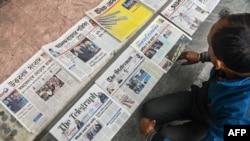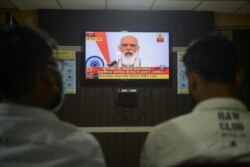India's government says press freedom is a fundamental right that is cherished, but media watchdogs have flagged what they say is a troubling reversal of rights.
Media watchdog Reporters Without Borders (RSF) described India as one of the "most dangerous countries for the world" in its annual assessment of global press freedom, citing the ruling party's increased pressure on media to "toe the Hindu nationalist government's line" and an atmosphere of hostility toward journalists who report critically on the government.
The Paris-based watchdog also cited the "worrying" situation in India-controlled Kashmir, where it says media outlets are threatened and obstructed from doing their jobs.
Daniel Bastard, head of Asia-Pacific desk at RSF, told VOA that under Prime Minister Narendra Modi's National-Populist ideology, content deemed critical of the government is accused of being anti-state and anti-national.
"Authorities use it as a pretext to clamp down on independent journalistic coverage," Bastard said. "This situation is all the more blatant in Indian-administered Kashmir, where any critical coverage is deemed 'anti-Indian', which allows security forces to intimidate and harass independent reporters."
For 2020, India retained its press freedom index ranking of 142 out of 180 countries, where 1 is the most free. But in other measures of democracy, it has declined.
On the Freedom of the World index, India was downgraded from "free" to "partly free." Freedom House cited a decline in media freedom under the current government as one of the reasons for the downgrade. In addition to legal pressure, journalists were facing more harassment and physical violence.
While acknowledging that India's media environment continues to be robust and diverse, Amy Slipowitz, a research manager for Freedom in the World, told VOA that the country's independent journalists are under "increasing pressure and harassment."
"Authorities have used an array of laws, including those related to security, defamation, sedition, and hate speech, as well as contempt-of-court charges, which have tempered critical voices," said Slipowitz.
Big business houses and powerful politicians have primarily controlled the press in India, said Ashok Swain, the head of the peace and conflict department at Sweden's Uppsala University. "Thus, press freedom in India has been traditionally relatively weak in the sense that it has been usually pro-establishment."
When nationalism became the guiding policy of the ruling party, India's press freedom has deteriorated hugely, the academic said.
India's Ministry of Information and Broadcasting did not respond to VOA's emails requesting comment.
On World Press Freedom Day, Information Minister Prakash Javadekar tweeted that press freedom is "part of fundamental rights" and that "it was only during emergency days when this freedom was muzzled by Congress."
Independent media
Since the BJP's landslide victory in 2019, mainstream media have largely become a tool to promote the ruling party's views and records, analysts say.
"It is not uncommon for journalists in India to be charged with such absurd laws for doing stories that may not be in line with the administration," said Ismat Ara, a reporter with The Wire, one of India's leading news websites.
Ara said a complaint was filed against her and The Wire's editor, Siddharth Varadarajan, over an article about a family who alleged their son's death at a farming protest was caused by a police bullet and not a tractor accident. Delhi police had released security camera footage showing the vehicle hit a barricade and flip over, the Wire reported.
She added that another journalist, Siddique Kappan, was charged with sedition after being arrested while traveling to report on an alleged gang rape and murder in 2020.
"The country's environment of suppressing journalists, as well as increasing intolerance towards the Muslim community, make journalists like me, who come from this community, even more vulnerable," Ara said.
Smaller media outlets and journalists who try to do independent reporting face harassment, threats and, in some cases, have even been murdered. Others face lengthy legal challenges, sometimes filed in distant regions, that divert resources and time.
"These small media outlets and journalists facing a series of cases in different parts of India have to spend time and resources to attend the court proceedings and defend themselves. The cases of sedition against journalists have become very common," Swain said.
Bastard, of RSF, also cited an increase in legal pressures including First Information Reports — the first step in bringing charges — and cases filed under India's sedition law, which can carry a life imprisonment.
Under the previous government, 3,762 cases of sedition were filed between 2010 and 2014. Under Modi, 7,136 cases were filed between 2014 to 2020, said Mirza Saaib Bég, a Kashmiri lawyer and a graduate of NALSAR University of Law in Hyderabad.
"Every dissent and every criticism faces intimidation and subsequent detention or extra-judicial violence," said Bég, a Kofi Annan and Weidenfeld-Hoffman scholar of public policy at the Blavatnik School of Government, University of Oxford.
Media resilience
For the Kashmir Walla, an independent news outlet in India-controlled Kashmir, the threat of legal action is one of several challenges.
The region's media have come under greater restrictions since the Modi government revoked the disputed region's autonomy in 2019.
At a time when the world was moving toward 5G high-speed internet, India imposed a 550-day communication blockade in Kashmir, citing national security concerns and the prevention of terrorism. The blockade, along with orders for media to not cover live clashes between police and militants, and arbitrary arrests, made it challenging for media to cover the pandemic, unrest, and other pressing issues, but they showed resilience in finding ways to still get news out.
The Kashmir Walla receives no government advertising — a common source of steady income for media in India — so instead uses subscriptions, grants and limited advertising revenue to survive.
"We don't have any link with government except registration as per law which is mandatory. So [the Kashmir Walla] is different from all the media houses in Jammu and Kashmir and we have been the only ones reporting everything, without censorship, in the aftermath of August 2019, when media succumbed to government pressure. We haven't stopped," its editor, Fahad Shah, told VOA.
The paper has also had to defend legal challenges to its staff. Shah and his staff are currently contesting three FIR complaints.
"In the last one year, I have been either detained or interrogated six times by police. There is a continuous attempt by the government, officially and unofficially, to silence us and stop our work. It only tells how important our work has been especially, in the last two years, and all these attempts have not stopped us," Shah said.
The Kashmiri directorate of information and public relations did not respond to VOA's emails requesting comment.
Journalists or media outlets are mostly attacked when they question the government, said Swain, of Uppsala University. Besides Kashmir, issues like anti-citizenship bill protests and farmers' protests have led to suppression of media.
Coverage of the government's handling of the COVID-19 pandemic was another source of pressure, with dozens of reporters arrested in 2020.
"The constant threat of being jailed, and no hope of getting justice from the judiciary [is] preventing many journalists and media outlets to cover the news of public and national importance," Swain said.










